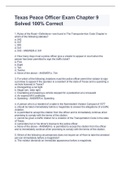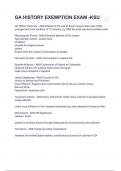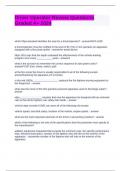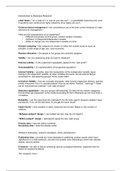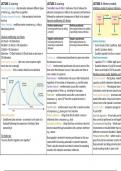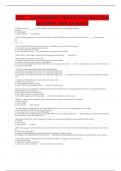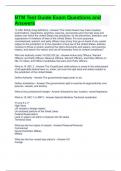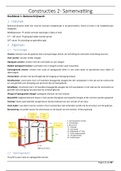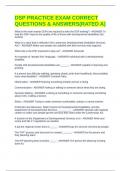Summary Literature Workshop Financial Analysis
Gruen R, Howarth A. (2005). Financial management in health
services. Open University Press. Chapter 9
To whom is a health care organization responsible?
As in large business organizations, very few health care organizations are
run by the people who own them. The people who manage organizations
are therefore held accountable to the owners for stewardship of the funds
(capital) with which they have been entrusted. In addition, organizations
may have many other interested parties or stakeholders who wish to
reassure themselves that the organization is being managed in their best
interests.
Organizations produce annual accounts designed to show their
stakeholders how the resources entrusted to them have been used. In
most countries legislation has been enacted to ensure that such accounts
give a true and fair view of the organization’s performance and financial
standing.
The need for a financial accounting system
Accounting systems, whether they are manual or computerized, help
organizations to ensure that all the transactions are conducted accurately
and at the right time. They also provide a comprehensive record of the
financial transactions that the organization has conducted. These records
are used to compile the income and expenditure figures used in budget
variance analysis. At periodic intervals (usually annually) the records are
summarized to produce accounts, which will be available to stakeholders.
Accounting periods are often selected by organizations to coincide with
the fiscal (tax) year.
The double entry bookkeeping system
Double entry bookkeeping: a system of record keeping, which recognizes
that there are two sides to every transaction. Each transaction involves
two entries, referred to as debit and credit entries. Double entry
bookkeeping reflects that each financial transaction has a giver and a
receiver, in other words it describes the ‘sources’ and ‘uses’ of funds.
- Asset: something that will be used in running the organization; it
represents the use of organizational funds
- Liability: refers to how the asset is funded – the source of funds.
- Capital: the funds invested in the organization by its owner or
owners.
All assets of an organization are at any time equal to its owners’ capital
plus any outstanding liabilities. This identity is referred to as ‘the
accounting equation’: Assets = capital + liabilities
At the end of each accounting period the first test of accuracy is to ensure
that the total debits are equal to the total credits. Thus a list of all
balances, the trial balance, is prepared and it is this that forms the basis
for the preparation of the financial statements.
1
, The annual report and accounts
The annual report is usually drawn up to give full and detailed information
on the organization and its activities over the previous accounting period.
Increasingly, organizations use annual reports as an important way of
informing their stakeholders about their mission and their organizational
objectives, and the ways in which they are meeting them. To comply with
statutory regulations, however, annual reports must also include written
reviews by the chairman and the finance director, statements regarding
the accounting principles and conventions used and a set of financial
statements including:
- An income statement;
- A balance sheet;
- A cash flow statement.
The income statement
The income statement summarizes income and expenditure over a period
of time, usually a 12-month period in the case of statutory accounts. In
practice these summaries will be supported by notes to the accounts
providing further detail under each of the income and expenditure
headings.
The balance sheet
In contrast to the income and expenditure statement, which shows the
transactions over a period of time, the balance sheet shows the assets,
liabilities and capital of an organization as at a particular moment (on the
last day of the accounting period). It is often described as a snapshot of
the organization at a particular moment.
It is important to note that the preparation of the income statement and
balance sheet can only be undertaken after the end of the financial
accounting period and it may take up to several months before the
2
Gruen R, Howarth A. (2005). Financial management in health
services. Open University Press. Chapter 9
To whom is a health care organization responsible?
As in large business organizations, very few health care organizations are
run by the people who own them. The people who manage organizations
are therefore held accountable to the owners for stewardship of the funds
(capital) with which they have been entrusted. In addition, organizations
may have many other interested parties or stakeholders who wish to
reassure themselves that the organization is being managed in their best
interests.
Organizations produce annual accounts designed to show their
stakeholders how the resources entrusted to them have been used. In
most countries legislation has been enacted to ensure that such accounts
give a true and fair view of the organization’s performance and financial
standing.
The need for a financial accounting system
Accounting systems, whether they are manual or computerized, help
organizations to ensure that all the transactions are conducted accurately
and at the right time. They also provide a comprehensive record of the
financial transactions that the organization has conducted. These records
are used to compile the income and expenditure figures used in budget
variance analysis. At periodic intervals (usually annually) the records are
summarized to produce accounts, which will be available to stakeholders.
Accounting periods are often selected by organizations to coincide with
the fiscal (tax) year.
The double entry bookkeeping system
Double entry bookkeeping: a system of record keeping, which recognizes
that there are two sides to every transaction. Each transaction involves
two entries, referred to as debit and credit entries. Double entry
bookkeeping reflects that each financial transaction has a giver and a
receiver, in other words it describes the ‘sources’ and ‘uses’ of funds.
- Asset: something that will be used in running the organization; it
represents the use of organizational funds
- Liability: refers to how the asset is funded – the source of funds.
- Capital: the funds invested in the organization by its owner or
owners.
All assets of an organization are at any time equal to its owners’ capital
plus any outstanding liabilities. This identity is referred to as ‘the
accounting equation’: Assets = capital + liabilities
At the end of each accounting period the first test of accuracy is to ensure
that the total debits are equal to the total credits. Thus a list of all
balances, the trial balance, is prepared and it is this that forms the basis
for the preparation of the financial statements.
1
, The annual report and accounts
The annual report is usually drawn up to give full and detailed information
on the organization and its activities over the previous accounting period.
Increasingly, organizations use annual reports as an important way of
informing their stakeholders about their mission and their organizational
objectives, and the ways in which they are meeting them. To comply with
statutory regulations, however, annual reports must also include written
reviews by the chairman and the finance director, statements regarding
the accounting principles and conventions used and a set of financial
statements including:
- An income statement;
- A balance sheet;
- A cash flow statement.
The income statement
The income statement summarizes income and expenditure over a period
of time, usually a 12-month period in the case of statutory accounts. In
practice these summaries will be supported by notes to the accounts
providing further detail under each of the income and expenditure
headings.
The balance sheet
In contrast to the income and expenditure statement, which shows the
transactions over a period of time, the balance sheet shows the assets,
liabilities and capital of an organization as at a particular moment (on the
last day of the accounting period). It is often described as a snapshot of
the organization at a particular moment.
It is important to note that the preparation of the income statement and
balance sheet can only be undertaken after the end of the financial
accounting period and it may take up to several months before the
2

